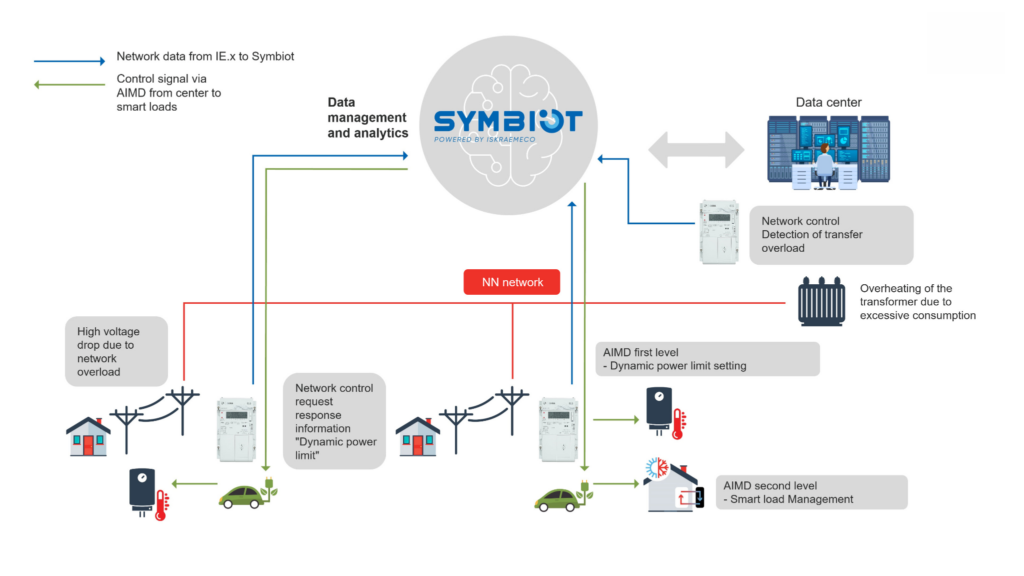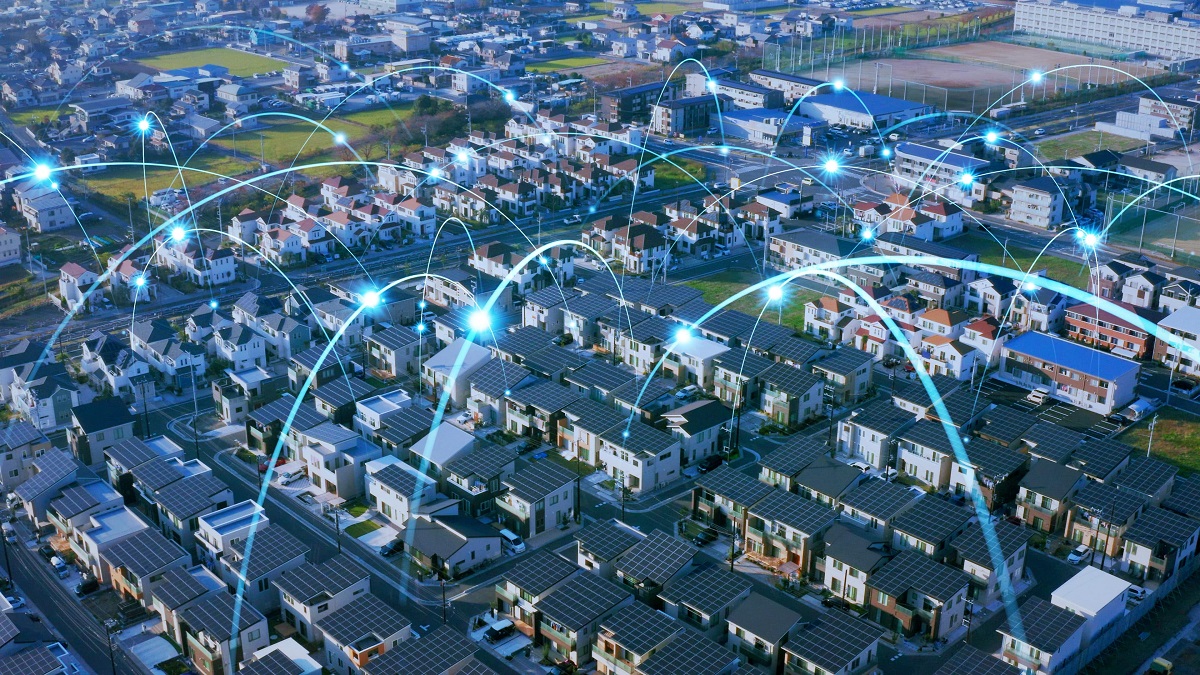Can we enhance the management of end-user energy consumption to prevent the grid from entering an undesirable state, thereby reducing consumption peaks and improving load distribution? Moreover, besides benefiting the electricity network provider, do we understand how this approach benefits end-users? Lastly, what additional components are required to ensure flexibility in the low-voltage grid?
To address these questions, we have developed a conceptual framework that considers two user types: residential (houses) and public (schools).
Each category has static loads that cannot be managed and flexible loads that can be remotely controlled.
Our framework demonstrates how maximum consumption can be controlled and maintained at desired levels, enabling the normal functioning of installed equipment such as cables, transformers and meters.
By involving end-customers, utilizing smart meters and leveraging existing equipment within the low-voltage network, we can significantly reduce the impact of solar power plants, electric vehicle chargers and heat pumps on the grid. This localized approach allows for the local operation and maintenance of the network, ensuring optimal power control without significantly affecting end-users’ daily routines and lifestyles. Additionally, we aim to showcase that proper standardization and collaboration among different industrial sectors can lead to a comprehensive, interoperable solution that eliminates the need for additional equipment to steer and control the network.
Situation today
In the current state of the art, the smart power grid is composed of various components, including sensors, actuators, physical quantity gauges for monitoring the network and its surroundings, information links and management systems. The core operation of the smart grid revolves around monitoring, control, and communication within the energy supply chain, with the goal of enhancing efficiency, reducing energy losses, optimizing energy supply and generation, lowering costs and improving reliability.
With technological advancements and an increasing focus on environmental protection, electrification is gaining momentum. The number of electrical and electronic devices has grown significantly, ranging from simple electrical appliances and electronically controlled actuators in various domains of life to telecommunications networks, appliances, and electric heating and cooling systems like heat pumps, electric heating panels, air conditioners, and electric vehicles and their charging stations. This proliferation of installations has resulted in a substantial surge in electricity demand and the complexity of ensuring adequate supply without overwhelming the grid. In practice, networks are becoming more extensive and diverse, often operating close to their capacity limits, which compromises their stability. Furthermore, the rise of distributed alternative energy sources, such as photovoltaic panels and wind farms, exacerbates this destabilization by introducing unpredictability into the grid’s operation.
Therefore, addressing the challenges posed by increased electrification and the integration of renewable energy sources requires innovative approaches to grid management and control. The development of smarter grid infrastructure, advanced monitoring systems, real-time data analysis and efficient energy management solutions will play a crucial role in ensuring grid stability, reliability, and optimal resource utilization in this evolving energy landscape.

Known state of the art
In the present state of the art, modern power grids are increasingly incorporating communication-enabled smart devices. At the consumer level, for instance, smart meters are installed at each location and are connected to a central server and other smart devices within the electrical network through a common communication network. In addition to measuring and recording the overall electricity consumption of individual consumers at that location, smart meters go beyond traditional electric meters by also measuring the real-time power usage of the site, including the combined power consumption of all individual users and any losses. These meters are equipped with processing and storage resources for recording relevant data, implementing algorithms, and establishing communication channels with the Central Communications Network.
While this centralized approach allows modern smart grids to support control, regulation, coordination and balanced operation, the complexity of the entire electricity network has made central control increasingly challenging. Centralized control encounters difficulties in promptly responding to changes in consumption or operation at various levels or branches of the power grid due to the intricacy of the task.
Maintaining a stable operation of the electricity network relies on achieving a balance between electricity generation and consumption, which becomes highly challenging due to the vast number of generators, consumers (demand points) and the overall diversification and complexity of the grid. To address these challenges, innovative approaches that leverage advanced technologies, such as decentralized control systems, real-time data analysis and intelligent algorithms, are being developed to enhance the stability, reliability and efficiency of modern power grids.
Current solutions
Current solutions for controlling and regulating the power grid aim to achieve a balance between electricity generation and consumption by centrally processing data on various factors, such as electricity generation and consumption, network conditions (e.g. external temperature, wind), grid failures and forecasts of changes in electricity generation. Algorithms are then employed to determine actions such as turning on/off individual consumers, transformer stations, branches of the grid, or electricity generators. Advanced artificial intelligence techniques, including neural networks, machine learning and genetic algorithms, are commonly utilized to control and regulate the electricity grid. These AI processes represent significant advancements in grid management and are made possible by increased processing power, larger storage capacities of central servers, and enhanced information flow through the communication network.
However, the current approach to grid control and regulation relies on a centralized model, where all the state information of the electricity network needs to be known and processed on a central server, typically serving as the data control, collection, distribution and processing center. This centralized control presents significant challenges due to the complexity of the electricity network, making the grid more susceptible to emergencies, both physical and cyber. These threats can result in infrastructure failures, privacy breaches, malfunctions or service unavailability.
Furthermore, the complexity of the electricity network, combined with sudden changes in electricity consumption or unforeseen incidents, can lead to delays in the regulation and provision of electricity. As a result, the grid may become unreliable in terms of stability and may not operate optimally.
To address these challenges, there is a growing need to explore decentralized approaches that distribute control and regulation capabilities across the grid. By adopting distributed control systems, real-time data analysis, and intelligent algorithms at various levels of the grid, it is possible to enhance the stability, resilience, and efficiency of the electricity network while reducing the reliance on centralized control and mitigating the associated vulnerabilities. These innovative approaches can provide faster response times, improved reliability, and better overall performance for the power grid.
Active load control
Active load control is a crucial mechanism for achieving dynamic balance between electricity production and consumption across the power grid. Its purpose is to enable automatic and robust control of the electricity network’s operation, ensuring that power generation and consumption are efficiently balanced. Furthermore, it allows for adjustments in response to factors such as ambient temperature or the performance of transformers, branches and levels within the electricity network. By doing so, active load control prevents overloading of the grid during peak demand periods, while still providing users with the required power supply.
One of the main advantages of active load control is its ability to achieve regulation using relatively simple algorithms that demand minimal processing power. This facilitates implementation at multiple levels, promoting a decentralized approach that reduces the complexity of individual algorithms. As a result, the control and regulation of the electricity network can be achieved in a more stable and responsive manner.
By leveraging active load control, the power grid can dynamically adapt to changing conditions and demands, ensuring a reliable and efficient supply of electricity. This approach optimizes the utilization of available resources and minimizes the risk of grid instability or failures. Furthermore, it enhances the ability to incorporate renewable energy sources and emerging technologies seamlessly into the grid, supporting the transition towards a sustainable and resilient energy infrastructure.
The technical problem is effectively addressed by implementing an Additive Increase Multiplicative Decrease (AIMD) algorithm at multiple levels within the power grid infrastructure. Specifically, the AIMD algorithm is applied at both the individual take-off sites and the low voltage transformer level.
Display of the steering concept

Conclusions
The system, apparatus and process are designed to facilitate automatic dynamic control of the electrical grid, ensuring a balance between electricity generation and consumption throughout the network. By avoiding grid overloading while meeting the maximum power demands of users, the system offers significant advantages.
The process utilises simple algorithms that require minimal processing power, enabling implementation at multiple levels in a decentralized manner. This decentralized approach reduces the complexity of individual algorithms and enhances overall system efficiency.
To address the technical challenge, an Additive Increase Multiplicative Decrease (AIMD) algorithm is employed at two crucial levels of the power grid: individual take-off sites and low-voltage transformers. Each AIMD server executes the first part of the algorithm, while each AIMD client executes the second part. This implementation ensures stable and responsive control and regulation of the electrical grid.




